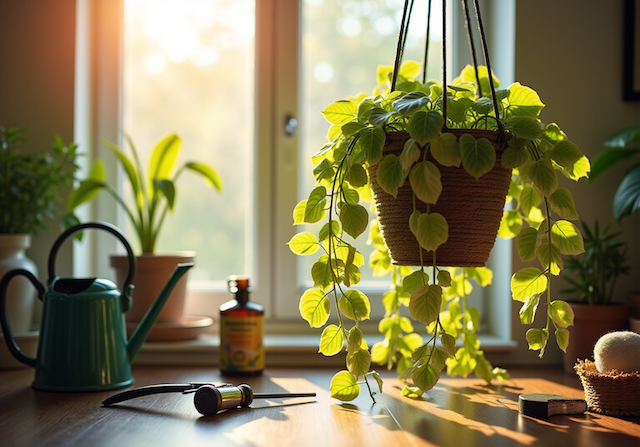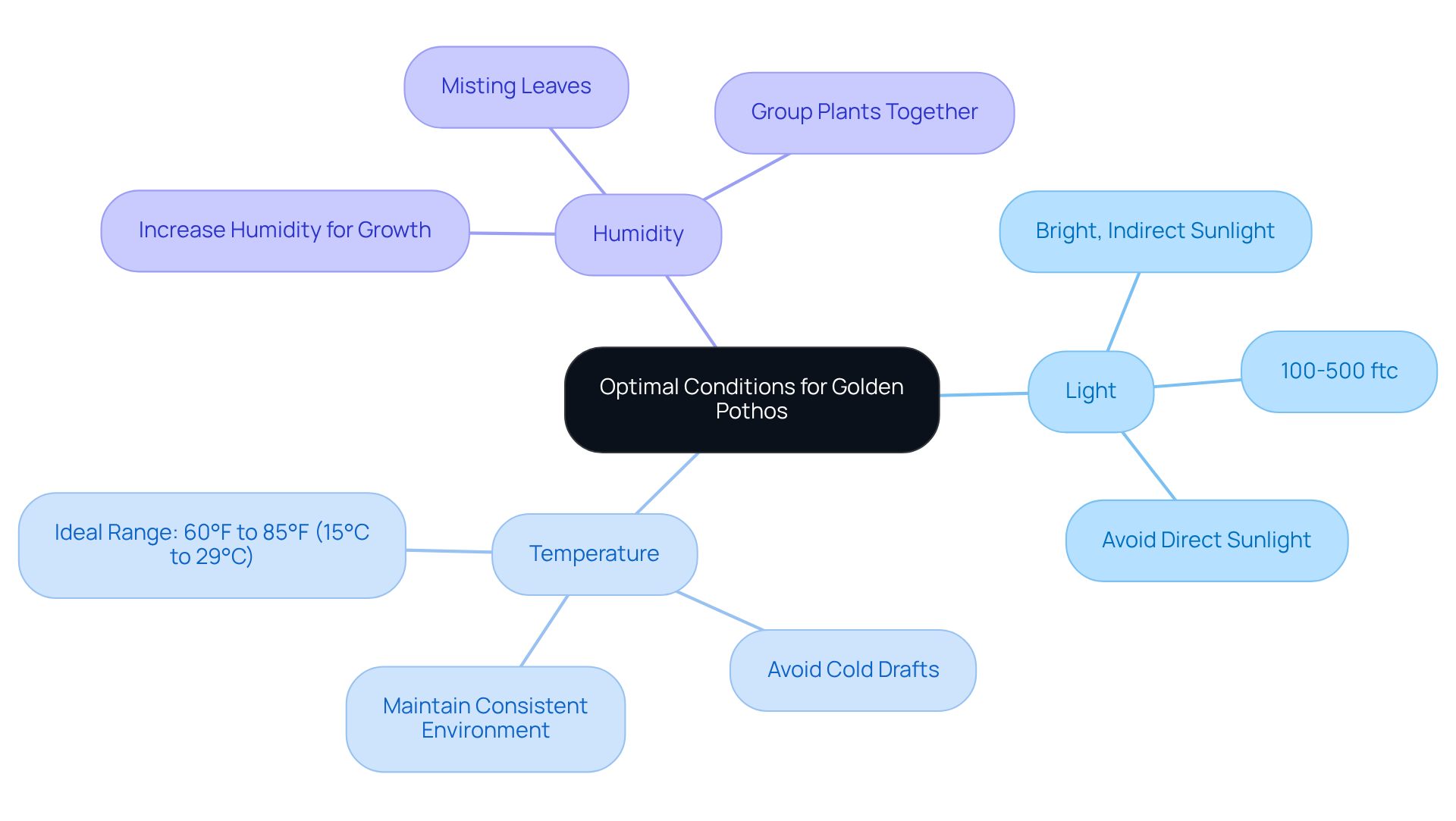
Master Golden Pothos Care: 6 Essential Steps for Home Gardeners
Share
Golden Pothos, recognized for its vibrant, heart-shaped leaves and remarkable growth potential, has become a favorite among indoor gardeners. This resilient houseplant not only enhances the aesthetic appeal of any space but also provides a rewarding gardening experience for those eager to learn its care requirements.
Despite its popularity, many gardeners face common challenges such as:
- Overwatering
- Insufficient light
- Pest infestations
To successfully cultivate Golden Pothos and transform indoor spaces into lush, green sanctuaries, home gardeners must unlock the secrets to its thriving growth.
Understand Golden Pothos: Characteristics and Care Needs
The plant commonly known as Golden Pothos, or Epipremnum aureum, is a popular houseplant admired for its striking, heart-shaped foliage, frequently showcasing vivid variegation in hues of yellow and green. This tropical vine, native to the Solomon Islands, flourishes in warm, humid environments, making it a perfect addition to indoor spaces. Understanding its is crucial for effective care.
- Growth Habit: The golden pothos can develop long vines, reaching heights of up to 40 feet in optimal conditions, though it typically grows around 10 feet indoors. This makes it an excellent option for hanging baskets or as a climbing vine.
- Light Requirements: While it flourishes in bright, indirect light, the golden pothos is exceptionally versatile and can endure low-light situations for extended durations. However, development may decelerate, and leaves may diminish in such conditions.
- Water Needs: This resilient plant is drought-tolerant and should be watered when the top 1-2 inches of soil feel dry. Overwatering can lead to root rot, a common issue that can be avoided by ensuring proper drainage.
- Soil Preferences: A well-draining potting mix is essential to prevent moisture retention, which can cause root rot. A mildly acidic pH ranging from 6.0 to 6.5 is perfect for optimal development.
- Fertilizing golden pothos every 2-3 months during the growing season promotes faster growth and overall health.
- Pest Management: Be aware of potential pests like mealybugs and spider mites, which can drain nutrients from the vegetation. Regularly inspecting your plant and using horticultural oil can help manage these pests.
By understanding these key characteristics and care requirements, you can create an ideal environment for your trailing plant to thrive, ensuring it remains a vibrant and healthy addition to your home.

Provide Optimal Light and Temperature Conditions
To ensure your golden pothos thrives, it is essential to provide .
Light: Position your Pothos in a location that receives bright, indirect sunlight. Ideal spots include areas near north or east-facing windows. Aim for a light intensity of 100-500 foot-candles (ftc), which is considered medium light. Avoid direct sunlight, as it can scorch the leaves, leading to damage.
The golden pothos flourishes in temperatures ranging from 60°F to 85°F (15°C to 29°C). It is crucial to keep the plant away from cold drafts and extreme heat sources, as sudden temperature fluctuations can induce stress. Abrupt declines in temperature or extended exposure to cold can damage indoor vegetation. Therefore, ensuring a consistent environment is crucial; temperatures exceeding 75°F (24°C) can be excessively high, particularly in low humidity.
Humidity: While this plant can tolerate average indoor humidity levels, increasing humidity can significantly enhance its growth. Misting the leaves or using a humidifier can be beneficial, especially in dry environments. Additionally, grouping plants together can help raise humidity levels around them.
By maintaining these conditions, you will create a flourishing environment for your plant, ensuring it remains healthy and vibrant.

Establish a Consistent Watering Routine
Establishing a consistent watering routine is essential for maintaining the health of your golden pothos.
- Frequency: Water your Pothos every 1-2 weeks, allowing the top 1-2 inches of soil to dry out between waterings. During the growing season in spring and summer, you may need to increase the frequency. Conversely, in winter, reduce watering as the growth of the plant slows down. It is important to note that most houseplants require 30-50% less water during winter months, so be sure to adjust accordingly.
- Method: Water thoroughly until it drains from the bottom of the pot, using approximately 500 milliliters (16 ounces) of water for a medium-sized pot. This practice ensures that the roots receive adequate moisture. Avoid allowing the plant to remain in stagnant water, as this can lead to root decay. Additionally, be aware that unglazed terracotta pots may require watering twice as often as those in plastic or glazed containers of the same size.
- Signs of Watering Needs: Monitor your plant for signs of underwatering, such as drooping leaves, or overwatering, which is indicated by yellowing leaves. Rather than adhering to strict schedules, learn to . Adjust your watering routine based on these observations to maintain optimal soil moisture.
By following these guidelines, you can provide your plant with the appropriate amount of water, fostering healthy development and vibrant leaves.
Fertilize for Healthy Growth and Vibrant Foliage
To promote healthy growth and vibrant foliage in your golden pothos, adhering to specific fertilization guidelines is essential.
- Type of Fertilizer: Opt for a balanced, water-soluble fertilizer with an NPK ratio of 20-20-20, or consider a specialized houseplant fertilizer. Foliage species such as golden pothos thrive when provided with fertilizers rich in nitrogen. Organic options, such as fish emulsion or worm castings, can also enhance soil quality and provide essential nutrients. When utilizing fish emulsion, dilute a few drops in your watering every week or two to encourage development without the risk of .
- Frequency: Fertilize every 4-6 weeks during the growing season, which spans spring and summer. As the plant's growth slows in fall and winter, it is advisable to reduce or cease fertilization to prevent nutrient overload.
- Application: Always dilute the fertilizer according to package instructions and apply it to moist soil to minimize the risk of root burn. Be cautious of over-fertilizing, as this can lead to salt buildup, resulting in browning leaf tips and stunted growth. If salt buildup occurs, flush the soil with water to remove excess nutrients.
By following these fertilization methods, you can ensure your plant flourishes, displaying its lush, vibrant leaves throughout the year. As Nadia Hassani, a Penn State Master Gardener, advises, "Always follow the label directions" to achieve the best results. Furthermore, consider performing a soil test prior to selecting a fertilizer to gain a clearer insight into your plant's specific nutrient requirements.
Prune to Promote Fullness and Remove Dead Growth
Pruning your golden pothos is essential for maintaining its health and appearance.
When to Prune: The optimal time to prune is during the growing season, specifically in spring and summer. This timing promotes new development and enables the plant to recover quickly from pruning. Late winter or early spring is ideal as the vegetation begins to awaken.
How to Prune: Utilize clean, sharp scissors or pruning shears to remove any dead, yellowing, or leggy stems. Make cuts just above a leaf node to stimulate branching and promote fuller growth. Be cautious not to remove more than 10% of the leaves at once to prevent shock to the plant. Additionally, certain plants may exude a sticky sap that can irritate skin and damage floors, so exercise caution during the pruning process.
Promoting Fullness: To achieve a bushier appearance, trim back longer vines and remove any sparse growth. This practice encourages the plant to generate new leaves and stems from the cut areas, enhancing its overall vitality.
Incorporating regular trimming into your care routine not only maintains the vibrant appearance of your golden pothos but also promotes its health. As horticulture professionals emphasize, "By removing those dead parts, you’re taking some of that work off your greenery’s plate and allowing it to divert its energy into healthy leaves and new growth!" Cleaning and disinfecting your pruning tools is also essential to prevent infecting plants with germs. By adhering to these guidelines, you can ensure your golden pothos flourishes in your home garden.
Identify and Resolve Common Issues
Maintaining the health of your plants, especially the golden pothos, requires vigilance regarding common issues that may arise.
- Yellowing Leaves: This symptom often signals overwatering or inadequate light. To address this, check the soil moisture; if it's soggy, reduce watering. Conversely, if the soil is dry, adjust your watering schedule and ensure the plant receives sufficient light, ideally bright indirect sunlight. Horticulturists emphasize that yellowing leaves can also indicate nutrient deficiencies, so consider a balanced fertilizer if the issue persists. Additionally, yellowing can occur due to natural variations in certain types, like Neon or Golden varieties, which may not necessarily indicate a problem.
- Leggy Growth: If your plant seems to be reaching for the light, it may not be getting sufficient illumination. Pothos can tolerate low light levels but will stretch if placed in very dark areas. To remedy this, rotate the vegetation regularly or move it to a brighter area, ensuring it avoids , which can scorch the leaves.
- Pest Infestations: Common pests such as spider mites, mealybugs, thrips, and others can threaten the health of your greenery. Regularly inspect the leaves for signs of infestation, including webbing or sticky residues. If pests are detected, treat the vegetation with insecticidal soap or neem oil, both effective solutions for managing these nuisances. Statistics show that a significant percentage of houseplant owners experience pest issues, highlighting the importance of proactive monitoring.
- Root Rot: If your plant is wilting despite regular watering, it may be suffering from root rot, often caused by excessive watering and inadequate drainage, allowing Pythium fungi to attack the roots. Carefully remove the plant from its pot, trim away any blackened or mushy roots, and repot it in fresh, well-draining soil. Ensuring proper drainage is crucial to prevent this condition from recurring.
By promptly identifying and addressing these common issues, you can help your golden pothos thrive and enjoy its lush, vibrant foliage.
Conclusion
Mastering the care of Golden Pothos requires an understanding of its unique characteristics and needs, enabling this stunning plant to thrive in any home environment. By providing optimal light, temperature, and humidity, alongside a consistent watering routine, gardeners can ensure their Golden Pothos remains vibrant and healthy. Incorporating proper fertilization and timely pruning not only enhances its growth but also improves its appearance, making it a rewarding addition to any indoor garden.
Key insights highlighted throughout this guide emphasize the significance of:
- Optimal light conditions
- A balanced watering schedule
- Regular maintenance to prevent common issues such as:
- Yellowing leaves
- Leggy growth
- Pest infestations
Awareness of these factors is crucial for any gardener aiming to cultivate a thriving Golden Pothos. Additionally, understanding the specific requirements for fertilization and pruning can greatly influence the overall vitality of the plant.
In conclusion, nurturing a Golden Pothos transcends mere adherence to steps; it fosters a deeper connection with the plant. By attentively responding to its needs and proactively addressing challenges, home gardeners can create an inviting space filled with lush greenery. Embrace the journey of caring for your Golden Pothos, and relish the beauty and benefits it brings to your home.
Transform Your Home with Lush Greenery Today!
Start your journey to thriving plants and vibrant spaces with Everglades Farm's expert care tips.
Frequently Asked Questions
What is Golden Pothos and what are its main characteristics?
Golden Pothos, or Epipremnum aureum, is a popular houseplant known for its heart-shaped leaves with vibrant yellow and green variegation. It is a tropical vine native to the Solomon Islands and thrives in warm, humid environments.
How does Golden Pothos grow?
Golden Pothos can develop long vines, reaching up to 40 feet in optimal conditions, but typically grows around 10 feet indoors. It is suitable for hanging baskets or as a climbing vine.
What are the light requirements for Golden Pothos?
Golden Pothos thrives in bright, indirect light but can also tolerate low-light conditions for extended periods. However, growth may slow down and leaves may become smaller in low light.
How often should I water Golden Pothos?
Water Golden Pothos when the top 1-2 inches of soil feel dry. It is drought-tolerant, but overwatering can lead to root rot, so ensure proper drainage.
What type of soil is best for Golden Pothos?
A well-draining potting mix is essential to prevent moisture retention and root rot. The ideal soil pH for Golden Pothos is mildly acidic, ranging from 6.0 to 6.5.
How often should I fertilize Golden Pothos?
Fertilizing Golden Pothos every 2-3 months during the growing season promotes faster growth and overall health.
What pests should I watch out for with Golden Pothos?
Potential pests include mealybugs and spider mites, which can drain nutrients from the plant. Regular inspections and the use of horticultural oil can help manage these pests.
What are the optimal light and temperature conditions for Golden Pothos?
Position Golden Pothos in bright, indirect sunlight, ideally near north or east-facing windows. It thrives in temperatures between 60°F to 85°F (15°C to 29°C) and should be kept away from cold drafts and extreme heat.
How can I increase humidity for my Golden Pothos?
While Golden Pothos can tolerate average indoor humidity, increasing humidity can enhance its growth. Misting the leaves, using a humidifier, or grouping plants together can help raise humidity levels.


